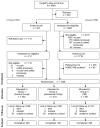A randomized trial of a tailored barriers intervention for Cancer Information Service (CIS) callers in pain
- PMID: 19406576
- PMCID: PMC2875780
- DOI: 10.1016/j.pain.2009.02.021
A randomized trial of a tailored barriers intervention for Cancer Information Service (CIS) callers in pain
Abstract
Cancer pain management can be improved by overcoming patients' attitudinal barriers to reporting pain and using analgesics. A simple cost-effective barriers intervention designed to reach a large number of persons with cancer has not yet been tested. Such an intervention should be tested against barriers' assessment-alone, as well as no-treatment control. The purpose of this study was to test the efficacy and the cost effectiveness of a tailored barriers intervention (TBI), an educational intervention tailored to participants' attitudinal barriers toward reporting pain and using analgesics. This was a randomized three-group (TBI, assessment-alone, or control) trial with measures at baseline and 28 days later conducted at the NorthCentral and Heartland offices of the Cancer Information Service (CIS), an NCI program that provides information to persons seeking answers to cancer-related questions. Participants (1256 adult CIS callers diagnosed with cancer with moderate to severe pain in the past week) joined the study and were randomized. Of these participants, 970 (77.23%) provided follow-up data. The TBI consisted of educational messages tailored to each participant's attitudinal barriers, delivered orally over the telephone, followed by a printed mailed copy. The outcome measures were attitudinal barriers to pain management, as well as pain outcomes (duration, severity, and interference with life activities). At follow-up the TBI group had significantly lower attitudinal barriers scores compared to assessment-alone and control, but the groups did not differ on the pain outcome variables. TBI and assessment-alone had similar cost effectiveness. The TBI needs to be strengthened to achieve reductions in pain severity.
Comment in
-
Tailored interventions: a test of strength and value.Pain. 2009 Jul;144(1-2):10-1. doi: 10.1016/j.pain.2009.04.026. Epub 2009 May 17. Pain. 2009. PMID: 19447548 No abstract available.
References
-
- Cleeland C, Syrjala K. How to assess cancer pain. In: Turk D, Melzack R, editors. Handbook of Pain Assessment. Guilford Press; New York, NY: 1992. pp. 362–87.
-
- Clotfelter C. The effect of an educational intervention on decreasing pain intensity in elderly people with cancer. Oncol Nurs Forum. 1999;26:27–33. - PubMed
-
- Crane L, Leakey T, Ehrsam G, Rimer B, Warnecke R. Effectiveness and cost-effectiveness of multiple outcalls to promote mammography among low-income women. Cancer Epi Bio Prevent. 2000;9:923–31. - PubMed
-
- De Wit R, van Dam F, Zandbelt L, vanBuuren A, van der Heijden K, Leenhouts G, Loonstra S. A pain education program for chronic cancer pain patients: follow up results from a randomized controlled trial. Pain. 1997;73:55–69. - PubMed
-
- DeVries H, Brug J. Computer-tailored interventions motivating people to adopt health promoting behaviors: introduction to a new approach. Patient Educ Couns. 1999;36:99–105. - PubMed
Publication types
MeSH terms
Grants and funding
LinkOut - more resources
Full Text Sources
Medical
Miscellaneous


